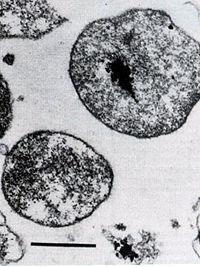Thermoplasma acidophilum: Difference between revisions
imported>Victor Wong |
imported>John J. Dennehy No edit summary |
||
| Line 1: | Line 1: | ||
{{subpages}} | {{subpages}} | ||
Revision as of 12:57, 18 May 2009
| "Thermoplasma Acidophilum" | ||||||||||||||
|---|---|---|---|---|---|---|---|---|---|---|---|---|---|---|
 | ||||||||||||||
| Scientific classification | ||||||||||||||
| ||||||||||||||
| Binomial name | ||||||||||||||
| "Thermoplasma Acidophilum" |
Description and significance
T.Acidophilum is a gram negative bacterium that varies from a spherical to filamentous structure. They can survive harsh conditions such as extremely low pH levels (0.5-4), and high temperatures (33-67°C).Like most extremophiles researchers have placed their emphasis on the proteins these microbes have, and their ability to survive high temperatures and low pH’s without denaturation occurring.
Genome structure
The genome of Thermoplasma is extremely small, and may very well be the smallest of all free-living bacteria. The genome size of Thermoplasma is about 109 Daltons.
Cell structure and metabolism
Thermoplasma lack rigid cell walls and are surrounded by a cytoplasmatic membrane. T. Acidophilium metabolize on extracts of yeast, meat, and eu- and archaea. The cell wall T.Acidophilum is composed of an unusual composition of glucose and mannose, this uniqueness allows the microbe to survive the harsh temperatures and pH.
Ecology
T.Acidophilium can aid in the decomposition process on those other organisms that could not survive the harsh conditions.
The discovery of T.Acidophilium was from an aqueous deposits on coal refuse. The microbe used the coal refuse as a source of nutrients.
Pathology
Does not appear to have any adverse effects on human beings.
Application to Biotechnology
Like taq polymerase did for PCR perhaps a similar application can be applied.
Current Research
References
1. Don Cowan,Nature 407, 466-467,28 September 2000